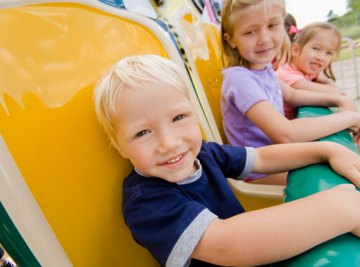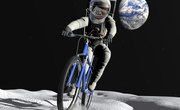
Amusement park rides use the laws of physics to thrill and excite riders. Because of this, rides make interesting science demonstrations for students studying the laws of motion. Tie your class science projects and demonstrations to amusement rides, then take a trip to an amusement park to enjoy physics in action.
Centripetal Force
A number of amusement park rides offer effective demonstrations of centripetal force. Demonstrate the force for your class by having students swing a bucket of water in a circle, observing that the water does not splash out even when directly overhead. Then, have your students ride on a ride like the Gravitron. The students will lean against padded panels that tilt outward and run along tracks. As the ride spins, centripetal force pulls on the riders, causing the panels to slide upward and taking the riders off the ground. If there is no Gravitron, have your students ride on a carousel or rotating swing ride.
Newton's Laws
Bumper cars serve as a demonstration of Newton's Laws of Motion. Demonstrate these laws ahead of time with marbles or toy cars; place a marble on a flat table and have students watch it to demonstrate that things at rest tend to stay at rest. Roll one across the table to demonstrate that things at motion tend to stay in motion. Roll one marble into another to demonstrate that, for every action, there is an equal and opposite reaction. Finally, roll a small marble down a track twice so that it hits another small marble. Then roll it down the track so that it hits a larger marble. Observe that it is harder to change the larger marble's momentum because it has more mass. Then, unleash your students on the bumper cars, where students can put Newton's laws into action by careening against each other.
Potential Energy
Use a marble jump to demonstrate potential energy. Start a marble from halfway up a ski jump shaped track and measure the distance that the marble flies. Then, start it from the top and measure the distance. The higher the marble is, the more potential energy it has, which gravity turns into kinetic energy as it rolls downward. Explain that this is just how roller coasters work: the coaster starts on top of a high hill to gather potential energy. That potential energy turns into kinetic energy as it rolls down the hill. The kinetic energy is what keeps the coaster moving through the whole ride. Let your students ride a roller coaster. If the coaster has loops, you can also discuss centripetal force.
Creating a Mini Roller Coaster
Have your students put it all together by building a mini roller coaster. Use vinyl tubing as a track, books or blocks as supports and tape or glue to hold the roller coaster together. Start the coaster at the top of a table and have it go down a big "hill," perform some loops or smaller hills and, finally, end at a low point. Time the amount of time the coaster takes with metal BBs of different weights.
References
About the Author
Isaiah David is a freelance writer and musician living in Portland, Ore. He has over five years experience as a professional writer and has been published on various online outlets. He holds a degree in creative writing from the University of Michigan.
Photo Credits
Creatas Images/Creatas/Getty Images
